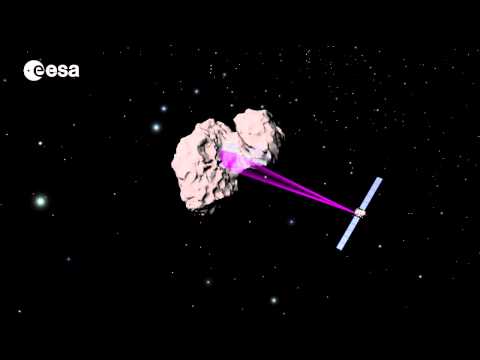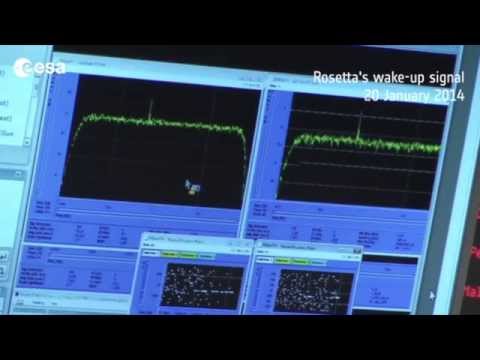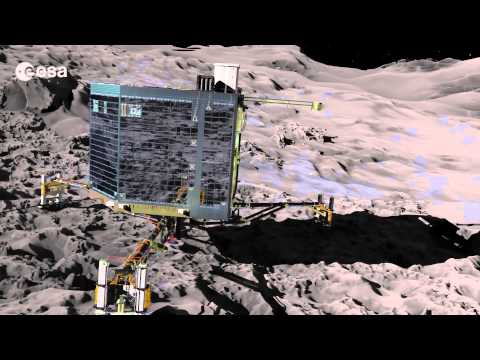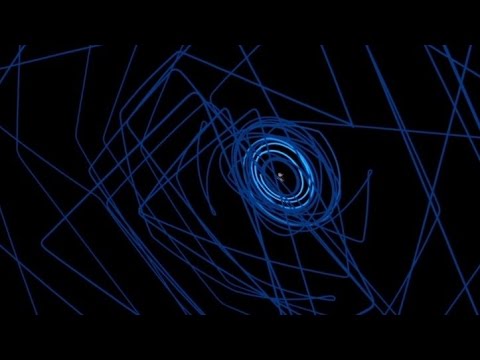Rosetta orbiting the comet
Animation showing Rosetta orbiting comet 67P/Churyumov-Gerasimenko and scanning its surface to make scientific measurements. The colours of the beams and their shape on the surface represent two different instruments imaging and analysing the comet.
The Rosetta orbiter has a total of 11 instruments to study the characteristics and environment of the comet. Rosetta will take images of the comet at a variety of different wavelengths, will make measurements of its gravity, mass, density, internal structure, shape, and rotation, and will assess the properties its gaseous, dust-laden atmosphere, or coma. It will also probe the surrounding plasma environment and analyse how it interacts with the solar wind.
Rosetta also carries a small lander, Philae, which will descend to the surface of the comet and make in situ measurements using its suite of 10 instruments.
The animation is not to scale; comet 67P/CG is approximately 4 km wide and Rosetta is 32 m across including its solar arrays. It will conduct its scientific investigations at a range of altitudes.
Credits: ESA





A look at how #Rosetta will orbit comet 67P/Churyumov–Gerasimenko and scan its surface to make scientific measurements (not to scale – comet 67P/CG is approximately 4 km wide and Rosetta is 32 m across including its solar arrays)
It is an amazing feat… how with you slow Rosetta down and insert it into orbit around the asteroid??? I imagine the gravity well of the asteroid is not very strong and the timing and speed of Rosetta will be crucial..
I found a rock for a princess @Rebecca Leblanc ….. I am not sure yet, how to deliver on a ring … it's 625 million kilometres away ….
J' ai dessiné le plan général du satellite Rosetta en 1997 dans un mémoire déposé à l'ENAC "Relativité d'échelle et propulsion photonique" et qui a été lu par des collègues du CNES qui ont collaboré avec l'ESA.
(Quand j'avais 12 ans ,j'ai vu tomber une météorite en Méditerranée dont l'éclat était comparable à celui du soleil, ce qui m'a vraiment étonné.)
Je suis donc content que cette idée qu' un satellite puisse étudier une comète de près et potentiellement la dévier en cas de collision avec la Terre voie le jour aujourd'hui.
Beaucoup d'industriels européens peuvent se réunir pour une mission qui intéresse toute la planète: c'est bien !
Toutefois,la trajectoire d'interception de la comète me semble trop compliquée,trop longue.
Je pense que cela est du au système de propulsion pas assez puissant.
Des efforts doivent être encore faits pour stocker l'énergie électrique de manière optimale et en plus grande quantité.
Les industriels européens devraient se réunir pour développer des SMES quantiques.
(cf mon profil : http://fr.linkedin.com/pub/jacques-puyuelo/36/183/3a1)
Le travail colossal déjà réalisé me semble remarquable.Il suffit de persévérer dans la bonne voie…
I watched the whole thing……..I did not see bigfoot
ESA what will the orbital speed be at 25K around the comet?
gtf dingle